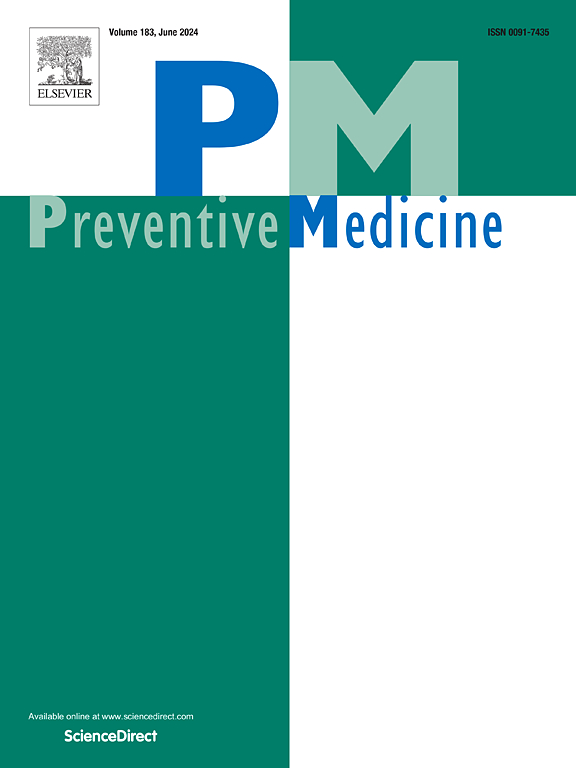转载:吸烟成年人在电子烟口味的吸引力、奖励和感官体验方面的性别差异。
IF 4.3
2区 医学
Q1 MEDICINE, GENERAL & INTERNAL
引用次数: 0
摘要
目的:香料通过改变感官体验来增强尼古丁电子烟的吸引力。女性可能对烟草相关线索更敏感,受香味的影响也更独特。目前的研究是一项探索性分析,旨在研究流行电子烟口味的奖励、吸引力和感官体验方面的性别差异:使用香烟(≥1 支/天)的成年人(N = 121)参加了一项实验室研究,他们在两种游离尼古丁浓度(6 毫克/毫升、18 毫克/毫升)中的一种中吸食了四种电子烟口味(烟草、樱桃、薄荷、香草;分别在不同的实验室环节中进行)。接触后,参与者使用药物效应问卷(DEQ)对电子烟的奖励进行评分,使用标签式享乐量表(LHS)对电子烟的味道和整体吸引力进行评分,使用广义标签式量表(gLMS)对味道的强度、刺激性、凉爽感、果味和甜味进行评分。结果采用线性混合模型来分析性别、口味和性别 x 口味交互作用的影响:在 DEQ 评分中,存在性别 x 味道交互作用的趋势(p = 0.08),其中女性的薄荷味道比其他味道产生更多奖励,而男性则没有。在 LHS 评分中,性别与口味的交互作用(p = 0.03)对电子烟的整体体验有显著影响,女性对薄荷口味的评分高于其他口味,而男性则没有。除刺激性外,所有 gLMS 量表均显示女性与男性相比在不同口味之间的差异更大(ps ≤ 0.03):结论:电子烟中的薄荷醇可能对女性的吸引力和/或奖励起着重要的中介作用。结论:电子烟中的薄荷醇可能在调解对女性的吸引力和/或奖励方面发挥了重要作用,部分原因可能是女性能够更好地检测电子烟的感官效果。本文章由计算机程序翻译,如有差异,请以英文原文为准。
Reprint of: Sex differences in appeal, reward, and sensory experience of E-cigarette flavors among adults who smoke cigarettes
Objective
Flavors enhance nicotine e-cigarette appeal by altering sensory experience. Females may be more sensitive to tobacco-associated cues and uniquely affected by flavor. The current study is an exploratory analysis to examine differences by sex on reward, appeal, and sensory experience of popular e-cigarette flavors.
Methods
Adults (N = 121) who use cigarettes (≥1 cigarette/day) were enrolled in a laboratory study in which they vaped four e-cigarette flavors (tobacco, cherry, menthol, vanilla; in separate lab sessions) in one of two freebase nicotine concentrations (6 mg/ml,18 mg/ml). Following exposures, participants rated e-cigarette reward using the Drug Effects Questionnaire (DEQ), flavor and overall e-cigarette appeal using Labeled Hedonic Scales (LHS), and intensity of flavor, irritation, coolness, fruitiness, and sweetness using Generalized Labeled Magnitude Scales (gLMS). Linear mixed models were conducted for outcomes to analyze effects of sex, flavor, and sex x flavor interaction.
Results
For DEQ ratings, there was a trend (p = .08) toward a sex x flavor interaction, in which menthol flavor produced more reward than other flavors for females, but not males. For LHS ratings, there was a significant sex x flavor interaction (p = .03) for overall e-cigarette experience with females but not males rating menthol higher than other flavors. All gLMS scales but irritation showed that females generally had greater differences between flavors compared to males (ps ≤ 0.03).
Conclusion
Menthol in e-cigarettes may play an important role in mediating appeal and/or reward among females. This may be due in part to their ability to better detect sensory effects of e-cigarettes.
求助全文
通过发布文献求助,成功后即可免费获取论文全文。
去求助
来源期刊

Preventive medicine
医学-公共卫生、环境卫生与职业卫生
CiteScore
7.70
自引率
3.90%
发文量
0
审稿时长
42 days
期刊介绍:
Founded in 1972 by Ernst Wynder, Preventive Medicine is an international scholarly journal that provides prompt publication of original articles on the science and practice of disease prevention, health promotion, and public health policymaking. Preventive Medicine aims to reward innovation. It will favor insightful observational studies, thoughtful explorations of health data, unsuspected new angles for existing hypotheses, robust randomized controlled trials, and impartial systematic reviews. Preventive Medicine''s ultimate goal is to publish research that will have an impact on the work of practitioners of disease prevention and health promotion, as well as of related disciplines.
 求助内容:
求助内容: 应助结果提醒方式:
应助结果提醒方式:


